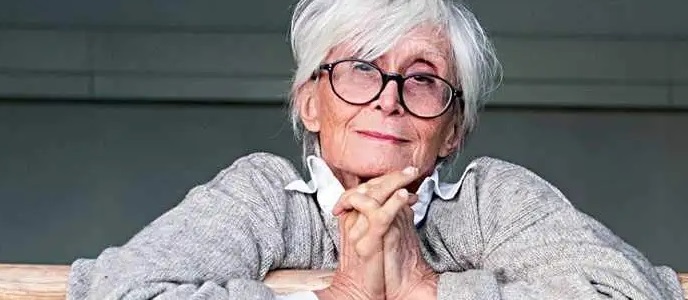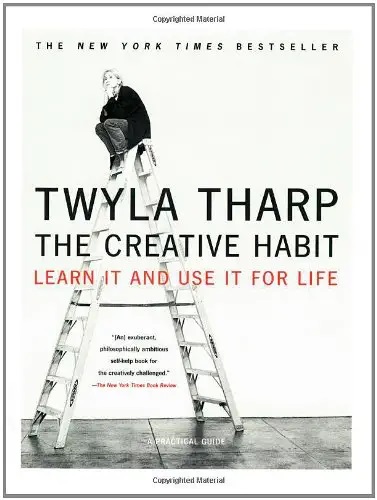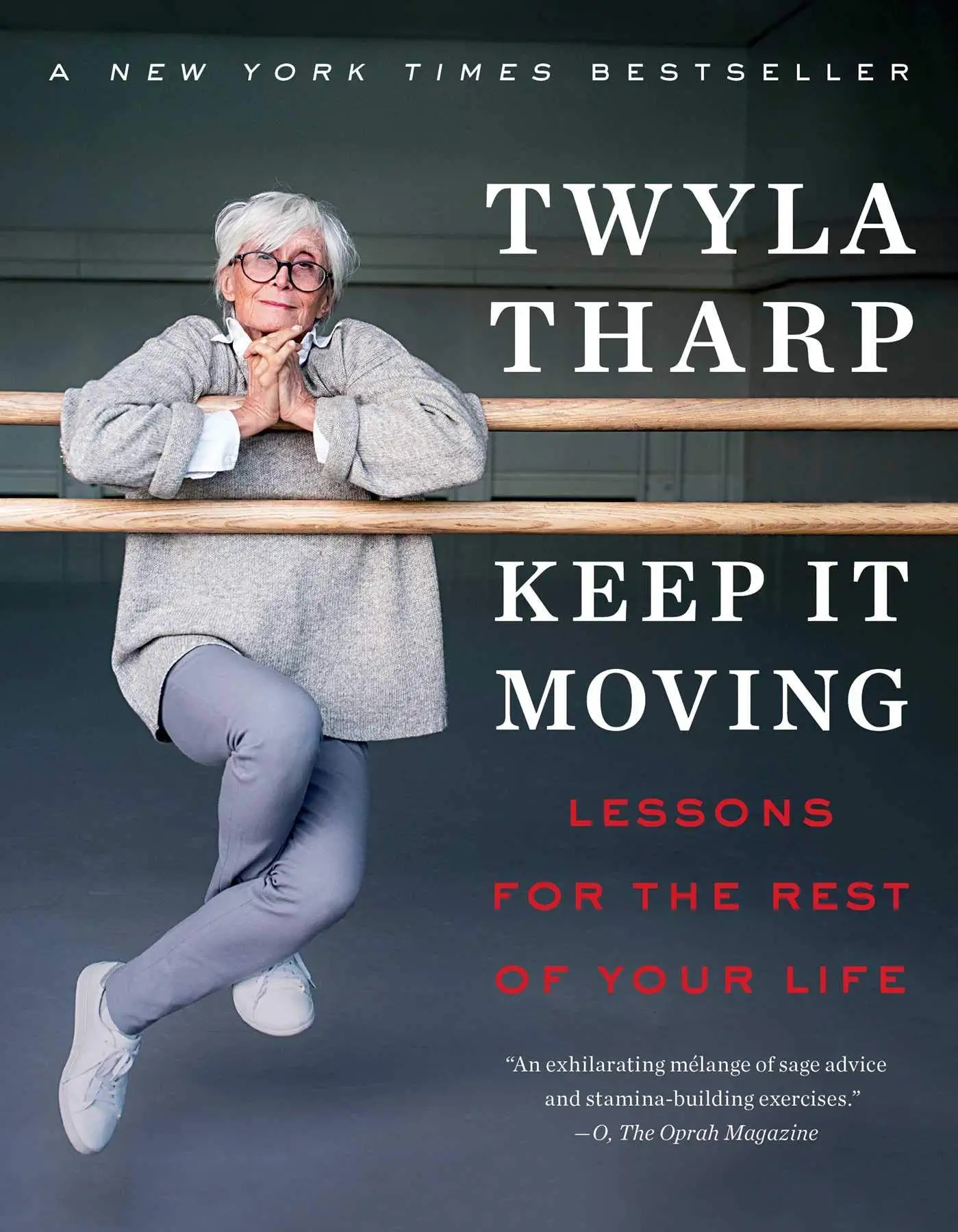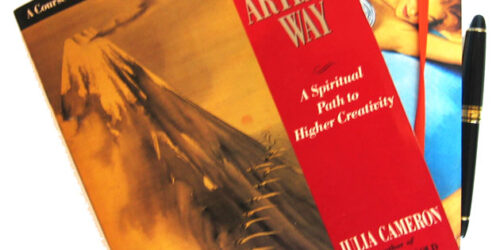Book review: Keep it Moving – lessons for the rest of your life by Twyla Tharp
Hanna’s review of the book Keep it Moving : lessons for the rest of your life by Twyla Tharp.

Dancer and choreographer Twyla Tharp, 80 years old, has written another book!
When I saw it out I knew I wanted to read it because I loved her first book, and now finally here’s my review of her book Keep it moving.
I read slowly, savoring a good book for weeks. I find myself relating the insights in a book to everyday existence, adding quality to my life.
Kaffe Fassett
So, Twyla’s new book is called Keep it moving – lessons for the rest of your life. It is about aging but not giving up. It is about movement (also known as exercise) but also about forward movement, keeping up with your “life pledge” which is not a goal or a list, but an idea that takes you out of bed each day.
Twyla gives plenty of examples of people with gusto and that has kept working all through their lives, like Monet who did his last artworks a few days before he died at age 86. Another example is how Agatha Christie wrote her beloved murder mysteries, and how our curiosity always takes us through the not-knowing until the end when all is revealed.
Twyla talks a lot about how to build stamina, and how to keep it by using movement. There are some quick prompts in the book with descriptions on how to do sky jumps (repeat many times, at least three), skii jump (repeat many times, at least four), walk with confidence and take up space in a room and so on. To me they feel like simple reminders to not just sit still reading or keep working at the computer…
She herself sometimes feel like a “sluggish mammoth” when she starts with her movement regime, but through the simple act of stretching and starting to move she finds energy. She writes:
“As hookey as it sounds, there simply can not be sustained forward motion in your life without the energy that optimism brings. Who wants to work towards failure?”
Is optimism more difficult with age? A bit, she writes, but gives further examples of famous people who didn’t give up with age but kept producing wonderful art. “There will be whining and kwetching” (new word for me), she writes, but we can turn to humor to make it easier.
She writes about how she feels uninspired on days when she has nothing scheduled, but asking if it shouldn’t be the opposite? Shouldn’t we feel excited about having a day of from regular tasks and work? But a friend of hers explained why this is via neurochemistry by saying:
“Our brains are wired to seek a reward. When we work toward a goal and achieve it, a big goal like landing a promotion or a small one like being on time to our kids reciting, a part of our brain (specifically our frontal cortex) is hit with dopamine which stimulates our pleasure center.”
When we “do the work” we get rewarded with a inner chemical blast that helps us want to do more work. Our motivation is lead by anticipation according to the book.
It sags when we have nothing to look forward to, it fades after we’re rewarded for doing the work. It peaks somewhere in the middle when we’re flush with feelings of expectations and confidence that a reward is coming.
I find this very interesting and noteworthy, how anticipation is something we need to create for ourselves weather it is in the near future in a couple of hours or something that will (might!) happen far in the future years. When we get older it might feel like there is less things to look forward to in the future, because the future is unsure. But also, it is a mindset. What we anticipate has to do with our optimism, if we can keep it – it will help us.
…balance is called peace, and it is the final resting place for bounce back. To obtain it we must practice daily, all of it. Getting started, blasting out, planning and pacing wisely, having the physical strength and the moral fortitude to keep going when nothing seams in our favor. To relish your highs and weather your lows, get up in the morning […] and acknowledge that you are still alive and move ’em out, over and over, time and time again.
Twyla also has something that she calls “the daily miracle” and it is something she encourages her readers to take notice of in their own lives. She defines it as “something that pleases you greatly first thing in the morning when your mind is fresh” and to share it with a friend. To me it sounds akeen to the gratitude list we’ve kept for years. To notice little miracles or think back on the things you’re grateful for is a wellness boost that costs you nothing, so why not give it a try?
I listened to the audio book read by the author, which makes the book feel like a stern talk from an elderly aunt that is trying to both encourage and propel you into taking care of your later years. I liked the book but felt it was at times a little without a red thread running through it.
Build your Creative Habit

Twyla’s first book was called Creative Habit (learn it and use it for life!) and it was a big hit with the creative community back when. If you were into creativity fifteen years ago chances are you own it already, but if not I recommend you to check it out because it is still available and I remember loving it when I read it back in the day, and it’s still in my book shelf.
Book reviews by iHanna
I read this book in an attempt to read more books for inspiration and motivation, because I feel like I forgot that those are available for me still. I am reviewing it for your benefit, of course. I love reading books, be it novels, thrillers, romance or inspirational books about knitting, creativity, arts and crafts or self-help like this one. I definitely read more than I review extensively – so upcoming will be a few of the inspirational books I think that you, as a creative, would like too.
Further reading
* Kaffe Fassett in the studio – a previous book review on the blog
* Keep it moving by Twyla Tharp on Amazon, check it out!
* You can find all my previous book reviews here










Thank you for sharing your thoughts on this book! I like the idea of always having/creating something to look forward to/learn to keep us moving forward. My hubby and I often joke that our to-do lists of projects we want to learn and do are so long we�ll never get to finish everything we�re interested in in this lifetime. But that�s also exciting, as we can pick and choose a project from a long list of things we�re already interested in and excited about! And we�re constantly adding to our lists!
Thanks for sharing your insights and lessons learned from this book!
I�m really glad you reviewed this book! I love her first one, and I think I borrowed this one from my library and didn�t get to reading it� I shall find it again now!
That almost happened to me this week; I had to return a book I was only half way through and I spent the evening and into the night reading it so I could finish on time! LOL
I’m so excited that you reviewed this book. I enjoyed her first one, have read it several times, but had not realized she wrote another book! I will be looking forward to reading this one too.
I am so happy that the review will help you find another good read! I didn’t like this one as much as the first one, but it’s definitely worth your time as well. :-)